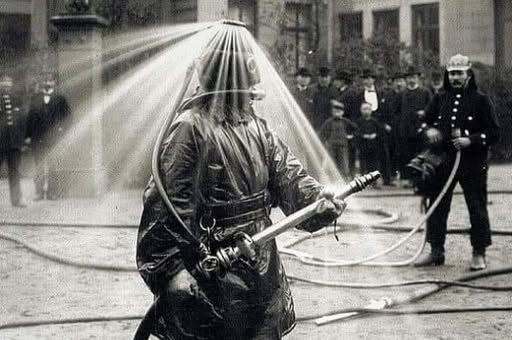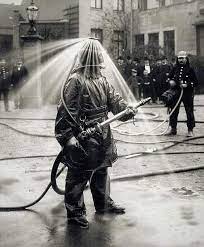The Self-Spraying Fire Suit: A 1900s Engineering Vision

The self-spraying fire suit developed in the early 20th century is an invention that demonstrates the unbridled audacity of engineering from that era. It wasn’t just protective wear; it was a mobile fortress designed to conquer the physical limitations of heat.
The Radical Design: Pressurized Water Shield

The central concept of this suit was to create a continuous, active water “shield” to deflect heat.
Integrated Spray System: The suit was equipped with a network of tiny tubes running across its body. Micro-nozzles were strategically placed all over the surface, particularly in the most vulnerable areas.
Principle of Protection: Rather than relying on simple insulation (the common approach), the suit employed the principle of evaporative cooling and humidity. Water, pumped at high pressure, created a thin mist or curtain around the firefighter. This curtain would immediately vaporize upon contact with extreme heat, absorbing the vast majority of the thermal energy and keeping the suit’s internal temperature significantly lower.
Operational Capability: Theoretically, the suit allowed firefighters to walk directly into the center of an inferno—places conventional gear couldn’t withstand.
Technical Hurdles That Prevented Adoption
Despite its incredible potential, the suit never saw widespread adoption due to the following practical challenges:
Water and Pressure Supply: The suit required a constant, high-pressure water supply. This meant the firefighter had to be tethered to an external hose or pump by a supply line, which severely limited their mobility and agility.
Complexity and Weight: The suit was cumbersome and heavy, demanding longer donning and doffing times, which is a dangerous factor in emergencies.
Visibility Issues: The thick layer of mist or steam generated by the spray system often severely reduced the wearer’s visibility, making navigation difficult in smoke-filled environments.
The self-spraying fire suit remains a “museum piece of ingenuity,” a powerful reminder of how readily 20th-century engineers embraced audacious ideas to overcome the most elemental of dangers. It proves that the road to modern technology is paved with ambitious, even if ultimately impractical, inventions.











